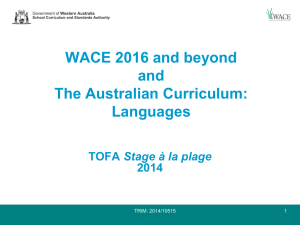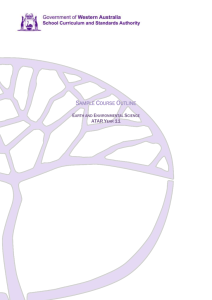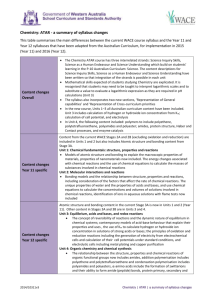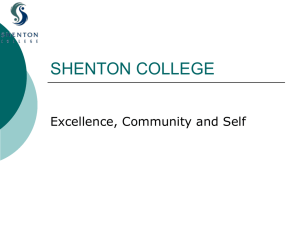Languages Learning Area Video transcript
advertisement
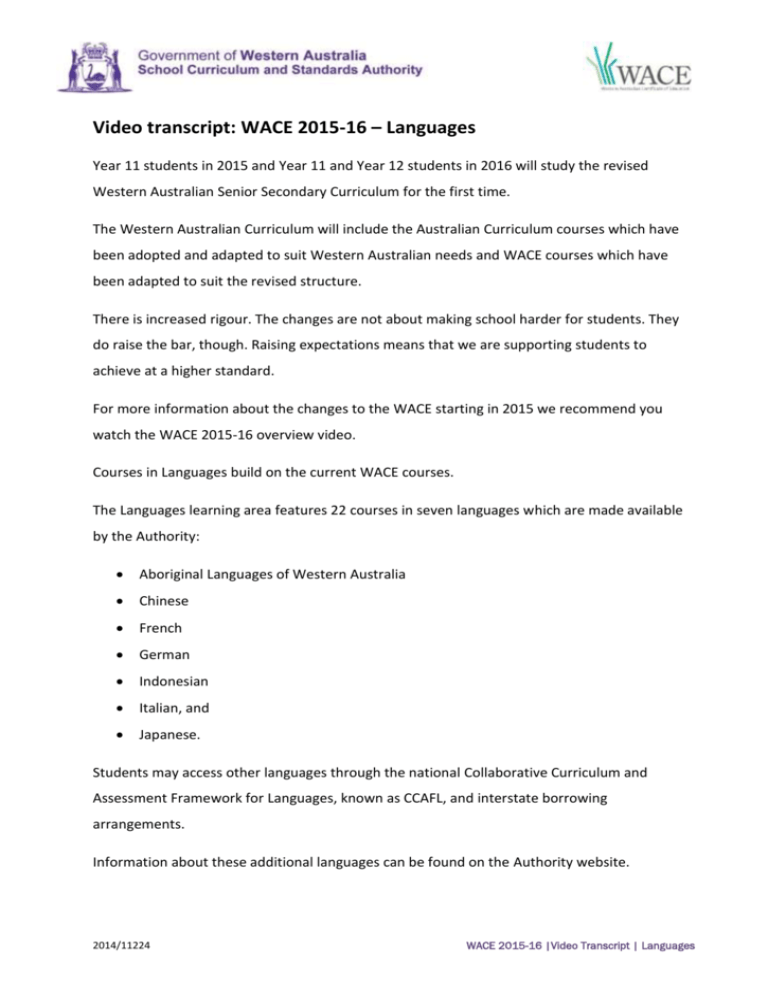
Video transcript: WACE 2015-16 – Languages Year 11 students in 2015 and Year 11 and Year 12 students in 2016 will study the revised Western Australian Senior Secondary Curriculum for the first time. The Western Australian Curriculum will include the Australian Curriculum courses which have been adopted and adapted to suit Western Australian needs and WACE courses which have been adapted to suit the revised structure. There is increased rigour. The changes are not about making school harder for students. They do raise the bar, though. Raising expectations means that we are supporting students to achieve at a higher standard. For more information about the changes to the WACE starting in 2015 we recommend you watch the WACE 2015-16 overview video. Courses in Languages build on the current WACE courses. The Languages learning area features 22 courses in seven languages which are made available by the Authority: Aboriginal Languages of Western Australia Chinese French German Indonesian Italian, and Japanese. Students may access other languages through the national Collaborative Curriculum and Assessment Framework for Languages, known as CCAFL, and interstate borrowing arrangements. Information about these additional languages can be found on the Authority website. 2014/11224 WACE 2015-16 |Video Transcript | Languages All Languages courses, except Aboriginal Languages of Western Australia which is available only as a General course, have either three or four pathways. Only students who do not have a cultural or linguistic background in the language may enrol in second languages courses. Students in the Second Language ATAR courses have typically learnt everything they know about the language and its culture through classroom teaching in an Australian school, or similar environment, where English is the language of school instruction. Second Language General courses are for those students who have no prior knowledge or experience of the language, or may have studied the language and culture through classroom teaching in an Australian school, or similar environment, where English is the language of school instruction. Background Language ATAR courses are aimed at students who have typically been brought up in a home where the language is used and they have a connection to that culture. These students have some degree of understanding and knowledge of the language. They have received all, or most, of their formal education in schools where English – or another language different from the language of the course – is the medium of instruction. Students may have undertaken some study of the language in a community, primary and/or secondary school in Australia. First Language ATAR courses are for students who will, typically, have spent some time as a resident and/or have had significant experience of studying the language in a country in which the language is a major language of communication. French, German and Italian have three pathways: Second Language General Second Language ATAR, and Background Language ATAR. The Background Language ATAR courses for French, German and Italian will be a new option for students sitting the WACE examinations in 2016. 2014/11224 WACE 2015-16 |Video Transcript | Languages Chinese, Indonesian and Japanese have four pathways. In addition to Second Language ATAR and Second Language General and Background Language ATAR, these languages are available as First Language ATAR courses. The Second Language General courses in Aboriginal Languages of Western Australia, Chinese, French, German, Indonesian, Italian, and Japanese are based on the current Stage 1 and Stage 2 units. Students who enrol in these courses gain knowledge and understanding of the culture and language of target language communities. The Second Language ATAR courses are based on the existing Stage 2 and Stage 3 units. Students who enrol in these courses further develop knowledge and understanding of the target culture and the language and refine their communication skills. Students who enrol in a Background Language ATAR course further develop their language capability through engagement with the target language-speaking communities, locally and overseas, and through the study of contemporary texts, topics and issues. The Background Language ATAR courses in French, German and Italian have been developed by the Authority. The Background Language ATAR courses in Chinese, Indonesian and Japanese have been adapted from CCAFL heritage courses First Language ATAR courses in Chinese, Indonesian and Japanese have been adapted from the Background Speakers’ courses from New South Wales. All students wishing to study a WACE language course are required to complete an Application for permission to enrol in a WACE language course in the year prior to the first enrolment in the course, to ensure that students select the course best suited to their linguistic background and educational needs. This information is available on the Authority website. There is a syllabus for each year of each course that sets out the content to be covered in each unit. The Year 11 syllabus details Units 1 and 2. The Year 12 syllabus details Units 3 and 4. 2014/11224 WACE 2015-16 |Video Transcript | Languages Units 1 and 2 are typically studied as a pair. Units 3 and 4 must be studied as a pair. The complexity of the syllabus content increases from Year 11 to Year 12. For this reason, a student cannot complete Year 12 units and then move to Year 11 units. Typically, the Year 11 and 12 Western Australian syllabuses follow the same structure. They all begin with a rationale and aims that are followed by information about the organisation of the course. Unit information includes a unit description, learning outcomes and unit content. Exceptions to this structure are Chinese, Indonesian and Japanese Background Language ATAR and First Language ATAR courses, as these do not include unit descriptions. The syllabuses include information about school-based assessment and grading, which is supported through grade descriptions. The grade descriptions have been modified from the current WACE courses. These are interim descriptions and will be refined during the early years of implementation. The grade descriptions are included in an appendix of the syllabuses. Many courses also have a glossary that defines key words in the context of the course. Consistent with the Australian Curriculum, the organisation section of the syllabuses includes reference to general capabilities and cross-curriculum priorities. The unit information, specifically the unit content, identifies the expected learning within each syllabus. Unless they are identified within the specified unit content, the general capabilities and cross-curriculum priorities are not assessed. Some syllabus elements are course and year specific. In general, the progression from Year 7–10 in the Year 11 syllabuses shows how the courses build on knowledge, understandings and skills. The Year 11 and 12 ATAR course syllabuses adopted and adapted from the Australian Curriculum are organised around the course aims and unit learning outcomes. The Year 12 ATAR courses contain the WACE examination design briefs. The Year 11 and 12 ATAR course syllabuses based on the current Stage 2 and Stage 3 WACE courses are organised around the course outcomes. 2014/11224 WACE 2015-16 |Video Transcript | Languages Year 12 General courses, except Preliminary, include information about the externally set tasks, known as ESTs, which are part of the Authority’s moderation processes from 2016. There are sample externally set tasks on our website. The Aboriginal Languages of Western Australia General course includes guiding principles and protocols which have been considered in the development of the course and should be used by schools when delivering any Aboriginal language in Western Australia. The rationales for all the Languages courses reflect the Australian Curriculum context statement for the language. The syllabuses also include an appendix in which the grammatical items from each unit are elaborated by examples. The syllabuses for Second Language ATAR and General courses include scoping and review of content to reinforce the focus, three learning contexts and related topics of each unit. They also include an appendix providing a common understanding of the features and conventions of the text types listed in the syllabus. In a similar way, each Background Language ATAR syllabus includes an appendix providing a common understanding of the features and conventions of the text types and kinds of writing listed in the syllabus. The Background Language ATAR syllabuses also include an appendix providing suggested subtopics to guide the treatment of the topics in Year 11 and the personal investigation in Year 12. The rationale for Aboriginal Languages of Western Australia General has been replaced by the Australian Curriculum: Draft framework for Aboriginal Languages and Torres Strait Islander Languages rationale. Outcome 1 has been split into two outcomes. Outcome 4 has been deleted. Instead, a fourth dot point referring to the ecology of the language has been added to outcomes 1, 2 and 3. Specified learning contexts for each unit have been added. Other changes include the rewording of the organisation of content and the synthesising of dot points and realignment of content to match unit focus and learning contexts. Along with this, 2014/11224 WACE 2015-16 |Video Transcript | Languages the sub-headings in cultural understandings have been changed to better align content descriptions in the dot points The 35 dot points under Learning and communication strategies have been moved to Appendix 2. A course unit is completed when a grade is assigned. This means a student must have had the opportunity to complete the structured education program and the assessment program, unless the school accepts there are exceptional and justifiable circumstances. The assessment program is summarised in the assessment table. You will notice the assessment tables for Second Language and Background Language ATAR and Second Language General courses now show fixed assessment weightings rather than having a weighting range. The names of the assessment types have been modified. In Second Language and Background Language ATAR practical (oral) and written have been included as separate assessment types and, for Year 12, there are separate assessment tables for practical (oral) and written assessments. Teachers of Indonesian: Second Language ATAR and General should note the inclusion of an additional assessment type – response: listening. Students enrolled in Year 12 ATAR courses are required to sit the examination. When sitting an external examination, it is critical that students make a genuine attempt. The Second Language ATAR and Background Language French, German and Italian ATAR courses have a practical (oral) and written examination. These examinations are set and marked in WA. For Second Language ATAR courses, the supporting information for the practical (oral) and written examination has been revised for clarity, consistency and conciseness. All practical (oral) examinations for Second Language ATAR courses now have three sections. 2014/11224 WACE 2015-16 |Video Transcript | Languages All written examinations for Second Language ATAR courses also have three sections, with the exception of Indonesian, which has two sections. The names for the sections of the practical (oral) and written examination are now consistent across all six languages. Please note changes to the Indonesian and Italian Second Language courses where audio visual texts have been removed from the response: viewing and reading section of the written examination. Also of note, is a change to the number of texts included in section one of the written examination in the French, Indonesian and Japanese Second Language courses. For the Japanese: Second Language course, section two now includes texts of up to 600 ji. In Section three Part a, the stimulus text is now approximately 75–100 ji. The Background Language Chinese, Indonesian and Japanese ATAR courses have a practical (oral) and written examination. The practical (oral) and written examinations are set and examined by interstate agencies. Although these courses and examinations are provided by an interstate agency they contribute to WACE requirements. First Language Chinese, Indonesian and Japanese ATAR courses have a written examination only. The examinations for these courses are set and examined by the New South Wales Board of Studies, Teaching and Educational Standards. Students who enrol in General courses, except Preliminary, must make a genuine attempt in the externally set task to complete a course. The ESTs will be written assessments. The Authority will inform schools during Term 3 of the preceding year of the section or sections of the syllabus content on which an EST will be based. The ESTs will be worth 15 per cent of a student’s final mark. More information about ESTs is available on the Authority website 2014/11224 WACE 2015-16 |Video Transcript | Languages The ESTs for all Languages courses include response: reading and viewing and written communication. Syllabuses will be reviewed typically on a five-year cycle, according to learning area. The schedule of review will be published in 2014. The Australian Government announced a review of the Australian Curriculum in January 2014. The report on the review is due to be completed by 31 July 2014. Any changes that the Australian and Western Australian Governments may endorse as a result of the review will be considered in the Western Australian syllabuses as part of our curriculum review cycle. A range of support materials for teachers can be found on the Authority’s website. We encourage teachers to participate in briefings and discussions and to register for the eCircular to keep up to date. 2014/11224 WACE 2015-16 |Video Transcript | Languages
